#Lahmacun pizza
Explore tagged Tumblr posts
Text
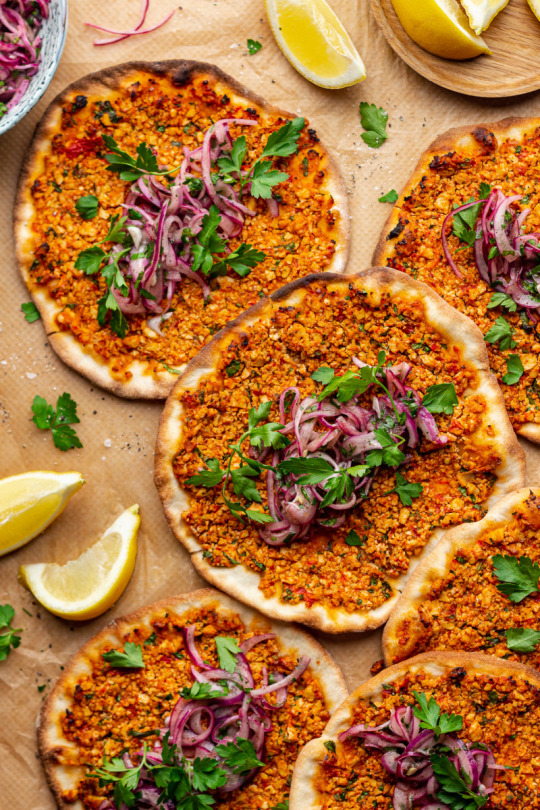
Vegan Turkish Pizza (Lahmacun)
#turkish#savoury#dinner#lunch#lahmacun#tofu#pizza#capsicum#food#recipe#recipes#vegan#veganism#vegetarian#plantbased#plant based#nut free#vegan recipes#vegan food#go vegan#veganrecipes#what vegans eat#veganfood#vegan recipe#vegan foodporn#cooking
22 notes
·
View notes
Text
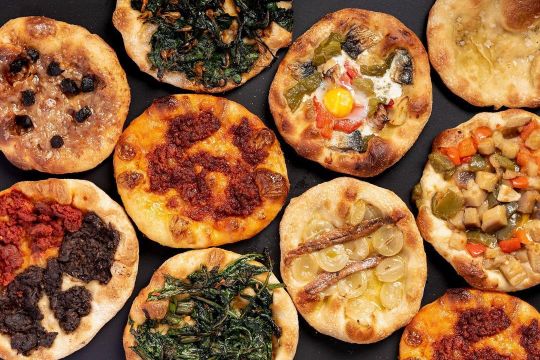
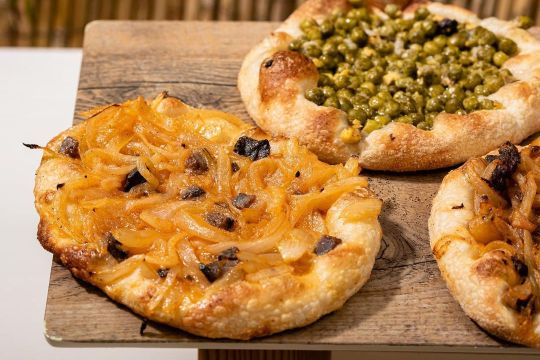
Different kinds of coques made in the Valencian style. Photos by Restaurant Pont Sec (Dénia, Central Valencian Country).
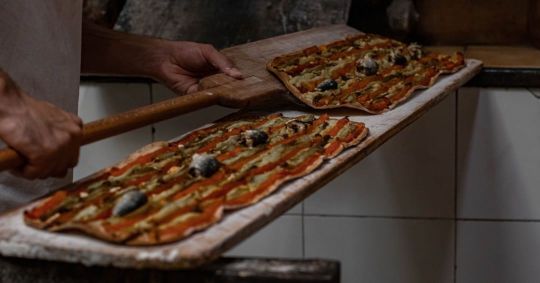
A coca de recapte. Photo by Forn Inalba bakery (Balaguer, Ponent, Catalonia).
Coques (singular: coca) are a traditional food eaten all around the Catalan Countries. It's a flat bread base similar to a pizza base and can have different toppings depending on what's in season in that time of the year. The most common toppings are tomato, peppers, aubergine/eggplant, garlic, onion, salted fish, local types of cured meat, pork sausages, and other local vegetables. Many towns or areas also have their own typical recipes.
The base can have a different shape depending on the area. In the central-south Valencian Country, they're round and so small that they can fit on a hand (like the photos included in this post). In Catalonia and the Balearic Islands they're usually big and rectangular with rounded edges, though some areas might also make them round.

(The areas coloured are approximate)
Even though the Neapolitan pizza is the one that has become famous all around the world thanks to the Neapolitan migration to the USA, this kind of flatbread base with toppings is a very common Mediterranean food since Ancient times. Different Mediterranean cultures eat variations of this idea.
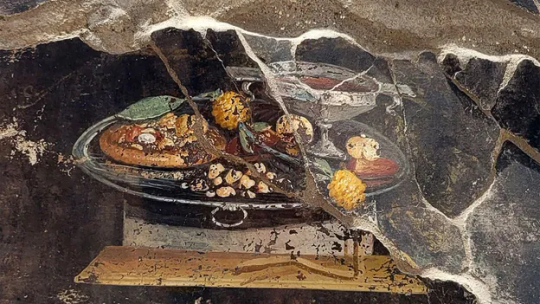
Ancient Roman fresco found in Pompeii that depicts a table with food, including a flatbread that looks similar to a pizza, though of course with different ingredients (tomato wasn't known in Europe at the time).
Coca is different from pizza because the base is slightly different and we don't use tomato paste nor mozzarella as a base. If they have cheese, it's goat cheese as a topping, melted on top of the other ingredients.
#menjar#coca#coques#mapes#pizza#pissaladiera#pide#lahmacun#food#foodblr#mediterranean food#food photography#bread#flatbread#map#travel#catalan#catalan food#italian food#turkish food#arab food#levant
136 notes
·
View notes
Text
La Cantina Meyhane - Lahmacun and Arabic Pizza
Here you can read my thoughts and feelings about the restaurant we held our second meeting at - La Cantina Meyhane and the gluten-free, turkish pizzas!
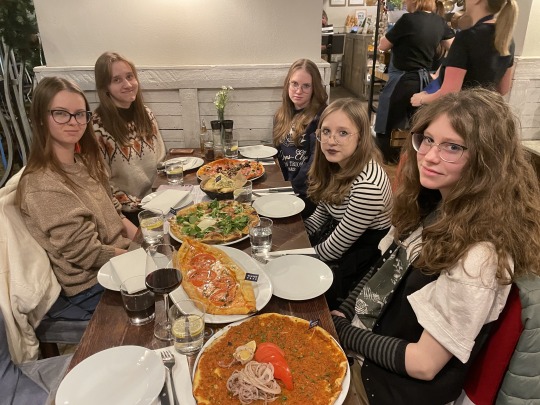
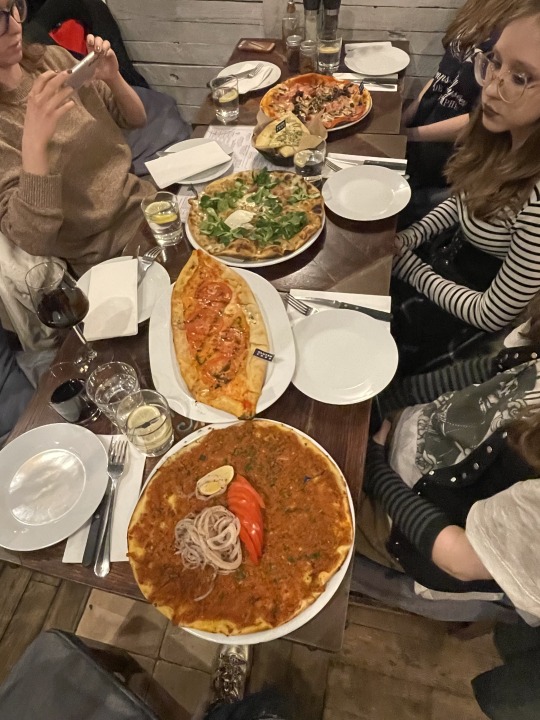
~ Alex.
The restaurant we went to on January 2nd 2024, is La Cantina Meyhane, one special restaurant. It specialises in italian cuisine the same as other italian restaurants, however this one offers every position on the menu as gluten-free! It is therefore including of people who can't have gluten, as well as offers vegeterian and vegan options in there menu! About the location, it just great; so-called New Town located in the centre of Warsaw and it's really close to both metro and the bus stop!
Other than the classic pizza, the meal of the week was Lahmacun. It's a Turkish kind of pizza, which originates from Middle East - specifically from Levant region - but due to being highly popularized in Turkey, it's usually named and recognized as Turkish pizza. What's specific for this kind of pizza, is that it's not prepared with cheese and its crust is thinner. It is usually made with minced beef or lamb, minced with vegetables, and then herbs are added to it. it is usually eaten rolled up! Other than this pizza, we also tried another kind of turkish pizza - Pide Caprese!
As you can easily guess from the paragraph above, we made a good decision to order Lahmacun and Arabic pizza, as well as some classic choices: pizza e pistachio, focaccia, and capriciosa. Benath this paragraph, you can see the photo of us making these tough choices, haha (tough, because really, there were so many other, tasty-sounding options to pick from!):

The wait for the pizzas didn't feel long at all to me, when they were served it felt like it was right on time :). I was really impressed with the amount of food we ordered and how good it all looked. You can see it beneath, as well as us starting to eat the pizzas <3:
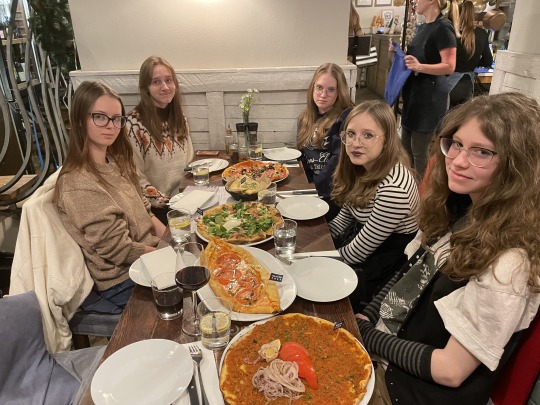
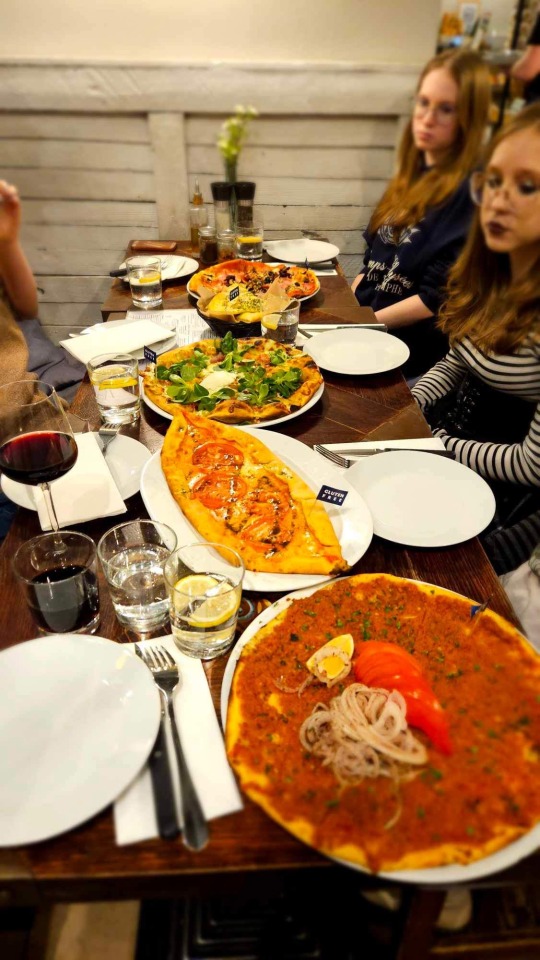
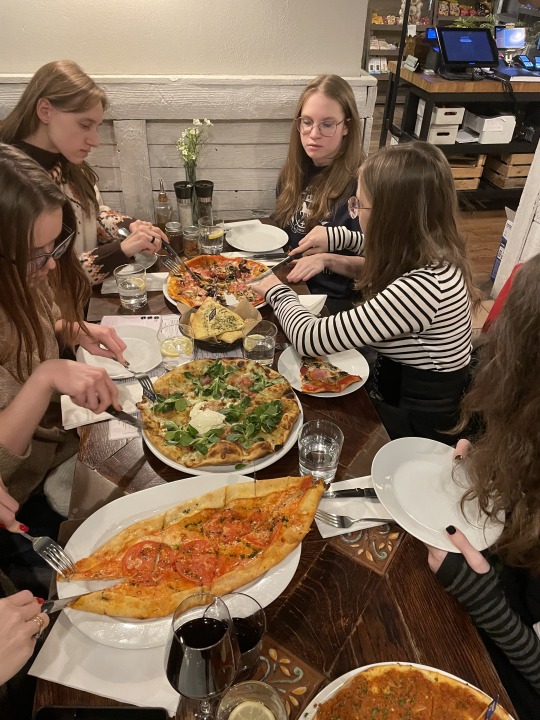
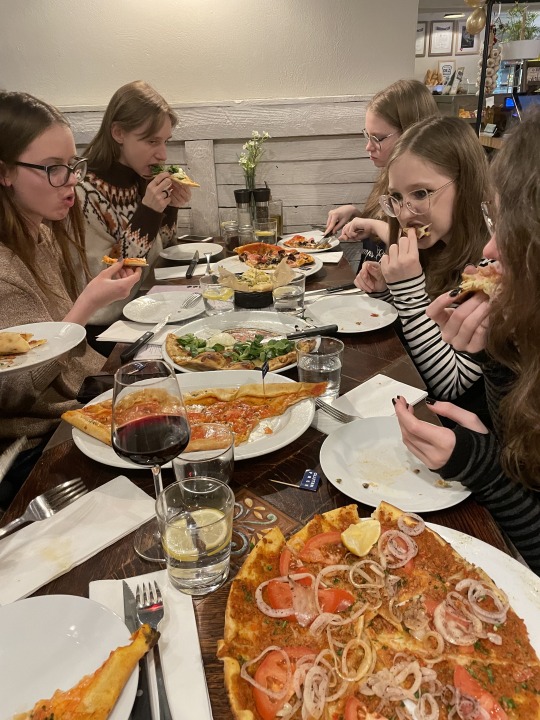
So finally, here are my thoughts about these special pizzas <3:
First, let's talk about the Turkish pizzas! The important thing to repeat here: they are just as gluten-free as other positions in the menu at this restaurant <3:
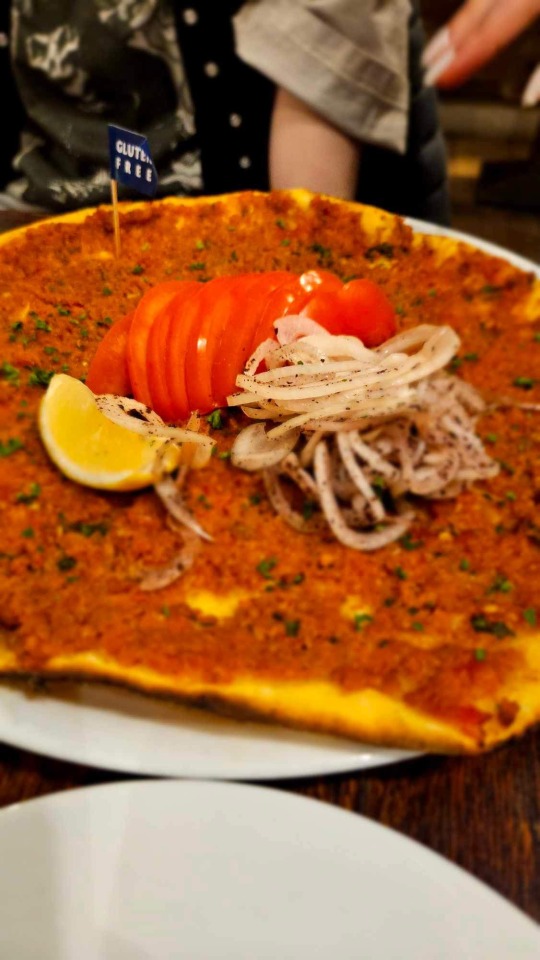
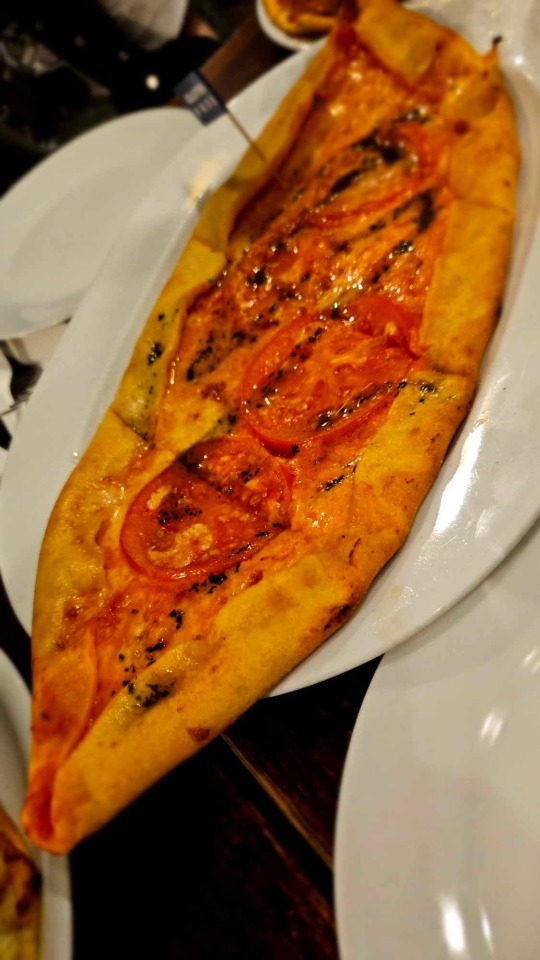
Lahmacun - this pizza had ingredients of beef filling with traditional spices, tomatoes, onions, parsley, and lemons. I found this pizza part spicy, part sour, sometimes sweet, and I did not expect it to be as dry as it was! It's a positive aspect of it, I found the taste of this pizza very specific, very interesting, and very tasty!
Pide caprese - oval pizza with ingredients such as tomato sauce, fior di latte, tomatoes, and basil pesto. It was not as dry as the first one felt to me, and the fresh tomatoes were delicious!!! I even caught myself wondering why am I finding this one so good… Well, it's obvious, haha! The tomatoes were sweet, the shape of the pizza itself made me happy, so I can openly say I fully enjoyed eating it <3.
Now, let's move to the classic gluten-free pizzas, that were just as good <3:
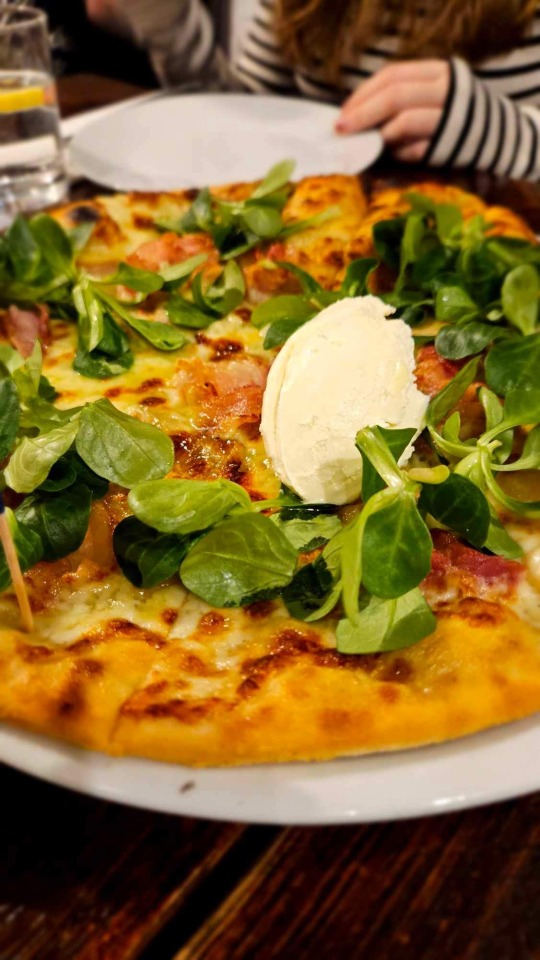
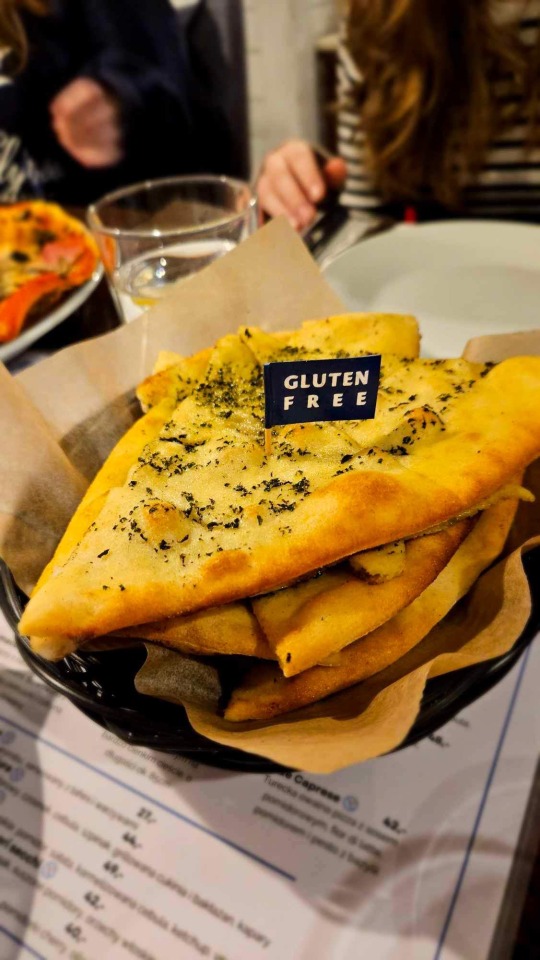
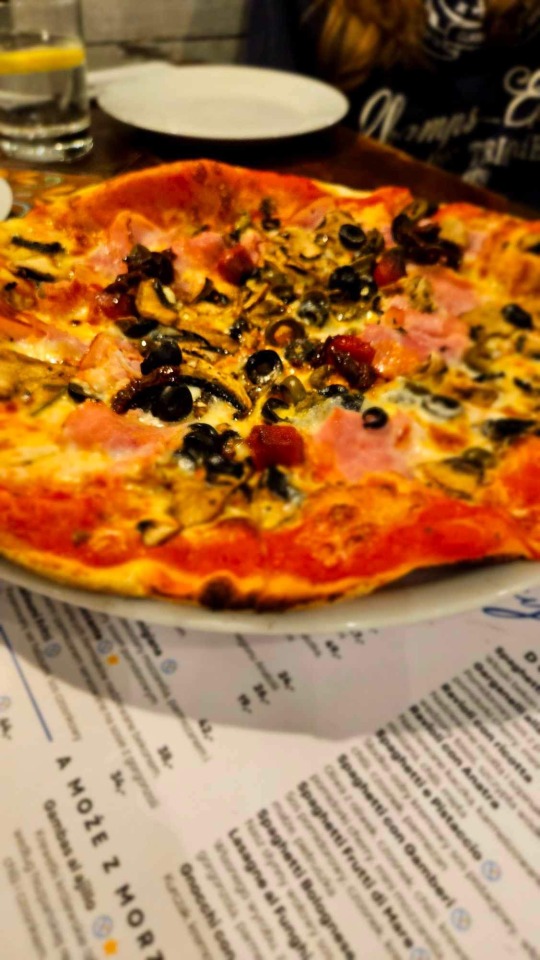
Pizza e pistachio - this pizza had ingredients of bacon, corn salad, a cheese I don't know anything about, buy which I think was delicious, and, obviously, pistachios! To be honest, I found the combination of the unidentified cheese and pistachios to be weirdly tasty, which went, suprisingly, extremely well for this pizza in my eyes, and is the reason why I think this one is my favourite!
Focaccia - I think we all know this one, I'd say it's one of the most basic pizzas to ever exist, but it still got me. It was a nice meal, a change of taste between the other pizzas, while also giving something special from its own ingredients combined together <3.
Capriciosa - the pizza with the ingredients of tomato sauce, fior di latte, ham, chorizo, eggs, dried tomatoes, mushrooms (champignons), and olives. I love the mix of mushrooms and ham, sue me, of course I loved it! And yes, again, the tomatoes of many kinds made this one ideal for me too, haha.*
This is what our table was like after we were done with these tasty-sounding (actually being, of course) options :3:

All in all, I'm happy to say this meeting was one of the most interesting ones yet! Sure, it was only the second restaurant, but I found it to be a curious case for me regarding all the pizza-related surprises and new experiences <3. So, I am ending this blog post thinking this meeting was a greatly positive one, and looking into our pizza-filled future with just as big optimism!
~ Alex.
*All ingredients come from the website of the restaurant.
#food blog#food#pizza#lahmacun#italian food#italian cuisine#turkish pizza#turkish food#turkish cuisine#restaurant#italian restaurant#alex
2 notes
·
View notes
Text
Lahmaçun o pizza turca
Hoy te enseño a preparar una lahmaçun o pizza turca.
Esta pizza, a diferencia de las de Italia, no lleva queso y las verduras se ponen en crudo y cortadas en trocitos pequeños para que queden crujientes.
Además, la lahmaçun puede comerse como cualquier otra pizza o como se come en Turquía, que es enrollándola sobre sí misma.
Para hacer esta receta he utilizado un molde para pizza de 30 cm. de diámetro con la base forrada con papel de horno para evitar que la masa se pegue al molde.
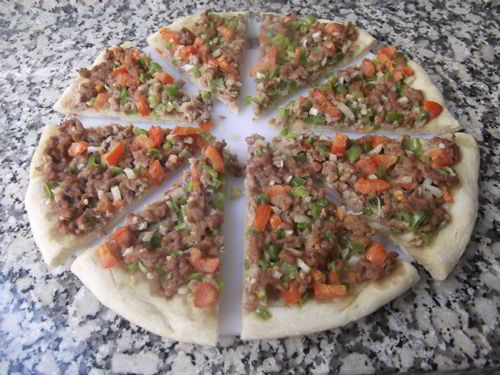
Para preparar esta lahmaçun o pizza turca necesitaras:
200 gr. de harina
150 ml. de agua tibia
2 gr. de levadura de panadero
Una pizca de sal
200 gr. de carne picada
1 pimiento verde
1 tomate pera
½ cebolla
Pimienta
Aceite de oliva
Para preparar esta lahmaçun o pizza turca debes seguir los siguientes pasos:
-Diluir la levadura de panadero en el agua tibia.
-Mezclar en un bol la harina, la levadura diluida en el agua tibia y la sal y amasar hasta conseguir una masa homogénea.
-Dejar fermentar la masa una hora tapada con un trapo.
-Pelar la cebolla.
-Picar la cebolla, el pimiento verde y el tomate.
-Mezclar la carne picada con la cebolla, el pimiento verde y el tomate y salpimentar al gusto.
-Estirar la masa con un rodillo dándole la forma deseada.
-Pintar ligeramente la masa con un poquito de aceite de oliva.
-Repartir la mezcla por encima de la masa.
-Hornear a 200º C durante 15 minutos.
8 notes
·
View notes
Text

#new york pizza#pizzalover#good pizza great pizza#fresh food#food#good food#good vibes#astethic#astetic#vibes#chill vibes#cozy vibes#love#ästhetisch#ästhetik#lahmacun#cat#darkness#black tumblr#dark aesthetic#dark
0 notes
Video
youtube
Kahvaltıda Sucuklu Yumurtalı Dev Pizza Lahmacun Tarifi
#youtube#giant pizzagiant pizza recipeturkish pizza lahmacun recipepizza lahmacunegg pizzaeasy recipesbreakfast recipesbreakfast ideashealthy breakfa
0 notes
Photo
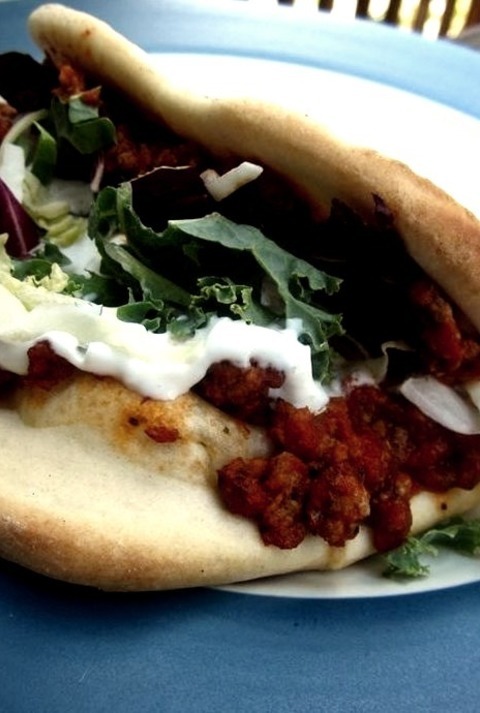
Lahmacun Turkish Pizza Recipe A flavorful sauce of ground lamb, herbs, tomatoes, and bell peppers top this Turkish flatbread. 1/2 teaspoon white sugar, 5 cups all-purpose flour, 1 pound lean ground lamb, 1/4 teaspoon crushed garlic, 2 teaspoons salt, 1/2 cup water, 1 teaspoon chopped garlic, 1/2 cup red bell pepper diced, salt and ground black pepper to taste, 1 yellow onion chopped, 1 cup shredded green cabbage, 1/4 cup vegetable oil, 1 cup shredded red cabbage, 1 cup plain yogurt, 4 roma tomatoes halved, 1/2 cup chopped fresh parsley, 3.25 teaspoons active dry yeast, 1/2 teaspoon chopped fresh parsley, 1/2 teaspoon ground cumin, 4 teaspoons olive oil, 1/2 cup green bell pepper diced, 1/2 lemon juiced, 1/2 teaspoon ground coriander seed, 3 tablespoons chopped fresh basil, 1/2 teaspoon paprika, 1 cup warm water, cayenne pepper to taste, salt to taste, 6 tablespoons double concentrated tomato paste, 2 tablespoons chopped fresh mint
0 notes
Text

Kaufe 2, erhalte 3. gratis! Genieße unsere köstlichen Gerichte im Doppelpack und erhalte 3 weitere völlig kostenlos. Eine unschlagbare Gelegenheit, unsere Speisen zu probieren. Komm gleich vorbei!
0 notes
Photo

European - Lahmacun Turkish Pizza This Turkish flatbread is topped with a flavorful sauce made from ground lamb, herbs, tomatoes, and bell peppers.
0 notes
Link
Hoe eet jij je Turkse pizza
0 notes
Photo
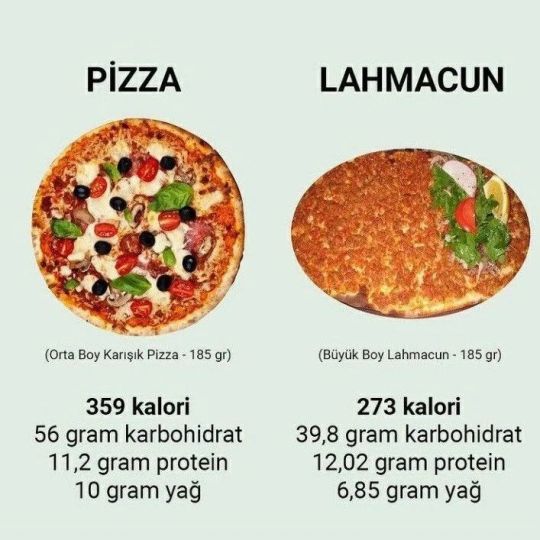
#pizza mı #lahmacun mu diye soranlara #gıda analizi ile cevap https://www.instagram.com/p/CoTAsXOLATcbBOpluQ3MddDWtvdTsoR75DmTJ80/?igshid=NGJjMDIxMWI=
0 notes
Text
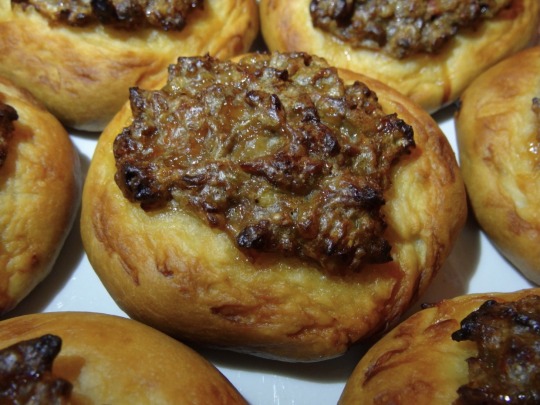
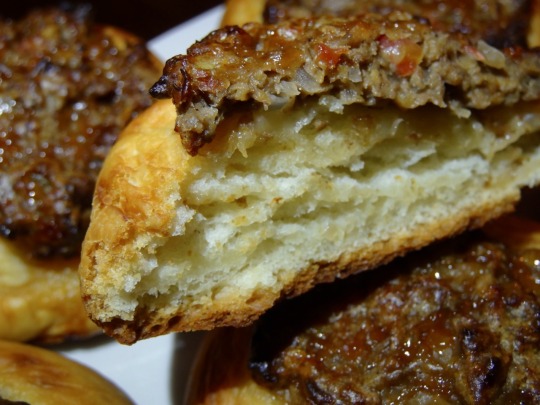
[ID: First image is a close-up on a plate of small flatbreads topped with ground ‘meat’; second is a cross-section of one of the breads. End ID]
صفيحة فلسطينية / Safiha falastinia (Palestinian topped flatbread)
Etymology and origins
صَفِيحَة (“ṣafīḥa”), also transliterated “sfiha” and “sfeeha,” is a flatbread eaten in Palestine, Lebanon, and Syria, comprising a yeasted dough topped with a filling made from ground lamb or beef, spices, and chopped aromatics and vegetables. It may also be called “اللَحْم بالعَجِين” (“al-laḥm b al-‘ajīn,” “meat with dough”)—this phrase is the source of the Turkish “lahmacun” and the Armenian “Լահմաջո” (“lahmadjo”), which describe a closely related dish.
The word “صَفِيحَة” literally means ��thin plate” or “sheet”; it comes from the root ص ف ح (ṣ f ḥ), which produces words related to flatness. Compare for example “صَفَّحَ” (“ṣaffaḥa”) “to flatten,” “صَفْحَة” (“ṣafḥa”) “page,” and “صَافَحَ” (“ṣāfaḥa”) “to shake hands.” This term has been borrowed into Brazilian Portuguese as "esfirra" or "esfiha," when the flatbread was brought to Brazil by Levantine immigrants—mostly Christians—beginning in the 1890s. Today, esfiha has been naturalized as a "'typical' Brazilian bar food"; it is said that the typical resident of São Paulo is a "Japanese who speaks Portuguese with an Italian accent while eating an esfiha."
In English, lahmacun (also transliterated "lahmajoun") is sometimes called "Armenian pizza." Similarly, it may be called "صفيحة الأرمنية" ("safiha al-'armaniyya"), "Armenian safiha," in Palestine, indicating that it is regarded as a borrowing from the local Armenian immigrant community. In Armenia, lahmadjo is a very thin, soft flatbread typically topped with beef or lamb, tomatoes, tomato paste, bell peppers, onion, garlic, parsley, red chili paste, and black pepper. With Palestinian safiha, lamb is the typical choice of meat; the dough may be thicker, and enriched with the addition of milk, milk powder, or yoghurt; bell peppers are ommitted; and fried pine nuts may be added. Palestinian restaurateur Nassar Odeh remembers lahmadjo being served in Jerusalem's Old City decades ago; he says that "Armenian dishes" such as this have become "part of the Palestinian culture."
Though the Arabic-derived "lahmadjo" and related terms may be heard, [1] the most common Armenian-language name for this dish is "լոշմիս" ("loshmis")—presumably from "լոշ" "losh" "lavash, thin bread" + "միս" "mis" "meat." Some Western Armenian variations on the name reverse this order (meat-dough, rather than dough-meat): "մսաշո��" ("msashot"), from "մսա" "msa" "meat" + "շոթ" "shot" "thin bread"; and "մսալոշ" ("msalosh"), from "մսա" "msa" "meat" + "լոշ" "losh" "thin bread."
The dish
A common part of everyday Palestinian cooking, صَفَائِح ("ṣafā'iḥ"; plural of "ṣafīḥa") are often eaten as a snack or a portable lunch. They may also be served as a مَزَّة ("mazza"; "appetizer") for عِيد ("'īd"; "feast," "holiday"; often transliterated "Eid") or Christmas.
Safa'ih are shaped into pinwheels in the port city of يَافَا ("Yāfā"; often transliterated "Yaffa" or "Jaffa"), stuffed with ground meat or spinach. In the Bethlehem region the topping is often mixed with tahina, as well as vinegar or lemon juice, and perhaps pomegranate molasses. Other versions of the meat topping omit tahina and vinegar, and are more tomato-heavy instead.
This recipe is for Bethlehem mazza-style safa'ih, with thick crust that's crisp on the outside and light and fluffy on the inside. Vinegar and pomegranate molasses provide a bright, slightly fruity lift to the topping, while tahina grounds it with a toasty, nutty aroma. Black pepper, allspice, and a green chili pepper add complexity and heat.
[1] There is a proliferation of possible spellings for "lahmadjo" in Armenian, which would indicate that it is a loanword (probably via Turkish, ultimately from Arabic). These spellings include "լամաջո" ("lamadjo") [common]; "լահմաջո" ("lahmadjo"); "լահմաջու" ("lahmadjou"); "լահմաջոն" ("lahmadjon"); "լահմաջուն" ("lahmadjoun") [literary; uncommon]; "լահմաջին" ("lahmadjīn"); and "լահմաջի" ("lahmadjī") [rare]. The letter "ջ" is pronounced as "dj" (IPA: [d͡ʒ]) in Eastern Armenian and a "tch" (IPA: [t͡ʃʰ]) in Western Armenian (timestamp: 40:33).
Support Palestinian resistance by donating to Palestine Action’s bail fund; buying an e-sim for distribution in Gaza; or donating to help a family leave Gaza.
Ingredients:
Makes 24 small safa'ih. Serves 24 as an appetizer, or 6-7 as a main dish.
For the dough:
5 cups (600g) white flour
1 cup (230g) non-dairy yoghurt (لبن رائب) (I used soy)
1/2 cup (125 ml) olive oil
1 1/2 Tbsp (15g) dry yeast
1/2 Tbsp (4g) kosher salt
1 tsp (5g) sugar
A scant cup (220g) of water
A more "everyday" preparation of this dish might make larger, flatter safa'ih out of a dough without dairy. This holiday variant includes yoghurt and makes smaller, fluffier safa'ih; but the yoghurt may be omitted (or milk or milk powder may be added) without injury, and the flatbreads can be made any shape you like.
Leila al-Haddad writes that, in Gaza, white flour used to be eaten as a treat and for special occasions before it later came to replace whole wheat white flour in many kitchens.
For the topping:
500g ground beef substitute (as a replacement for minced lamb)
1 medium tomato, minced
1 medium onion, minced
1-2 green chili peppers, minced
2 tsp kosher salt (1 tsp table salt)
3/4 tsp black pepper
3/4 tsp allspice; or Palestinian 7-spice / mixed spices (بهار مشكل)
1/4 cup white tahina
2 Tbsp pomegranate molasses
2 Tbsp white vinegar, or lemon juice
For a tomato filling, omit the tahina and vinegar, and instead use 2 Tbsp tomato paste; or 8 diced or puréed tomatoes, cooked down.
Instructions:
For the dough:
1. Combine all dry ingredients in a large mixing bowl.
2. Make a well in the center and add in the yoghurt, olive oil, and water. Mix them together and then combine them with the rest of the dough. Add water or flour as needed to obtain a soft, slightly tacky dough.
3. Knead the dough on a clean surface for 5-10 minutes, until it bounces back when pressed. Allow to rise, covered, in an oiled bowl for 1-2 hours, until doubled in size.
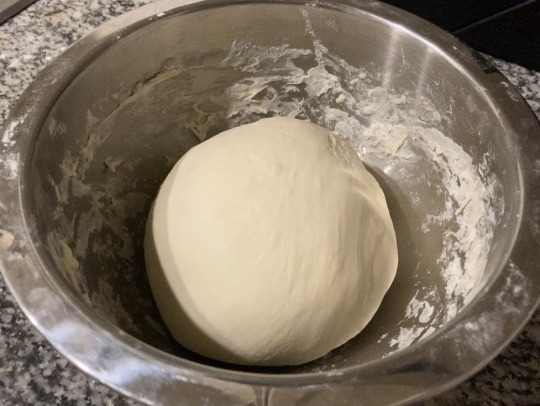
For the filling:
1. Mince vegetables, or run them through a food processor. Mix all filling ingredients together.
To assemble:
1. Divide dough in half, and then half again; roll out each quarter of the dough into a cylinder and cut it into six equal pieces.
2. Roll each piece of dough into a ball between your hands, and then flatten it into a disc about 1” (2 1/2 cm) high and 3” (8cm) wide. Place on a baking sheet prepared with parchment paper, leaving an inch of space between each circle.
3. Press the center of each dough circle down to create a crust around the edge. Add a few spoonfuls of filling to the center of each safiha and press flat.
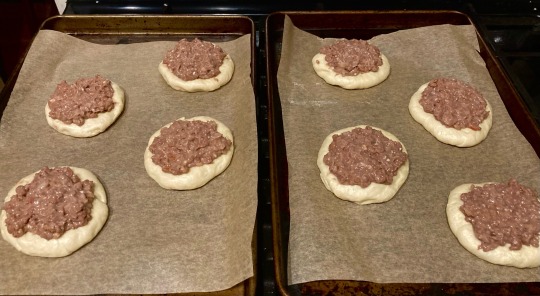
4. Bake safa'ih in the middle of an oven at 450 °F (230 °F) for 25-30 minutes, until crust is golden brown.
Serve as an appetizer alongside vegetable salads, pickles, olives, &c.
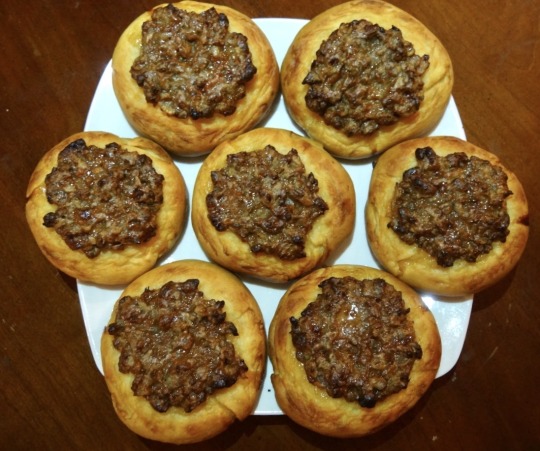
438 notes
·
View notes
Text
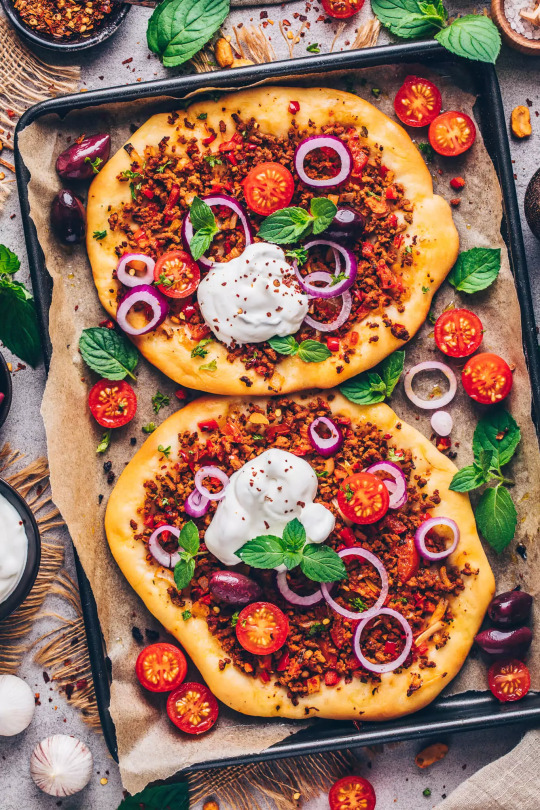
Vegan Turkish Lahmacun Pizza
#vegan#lunch#dinner#Turkish cuisine#middle eastern cuisine#west asian cuisine#flatbread#veganized#lahmacun#vegan mince#onion#garlic#tomatoes#avjar#bell peppers#parsley#olive oil#black pepper#sea salt#red onion#olives#tzatziki#mint
73 notes
·
View notes
Text

Lahmacun: Vegan Turkish Pizza
52 notes
·
View notes
Text
youtube
Prepara la pizza típica de Turquía, ¡te sorprenderá!
0 notes
Text
Made new gay (male, end 30s) friends from Istanbul last night. Woke up to a variety of awesome great authentic Lahmacun turkish pizza recipes and texts calling me the prettiest coolest Dutch girl
#My heart is full lol#I never go out anymore but when I do#Best of fun#His boyfriend lives in The Hague close to where I lived
8 notes
·
View notes